The United States needs to beef up its nuclear arsenal to deter adversaries including China and Russia, according to retired Navy Capt. James Fanell, former director of intelligence and information operations for the U.S. Pacific Fleet.
Fanell’s comments came as the U.S. Strategic Command prepared for its annual nuclear command and control exercise, Global Thunder, which started April 11.
Participation in the Global Thunder 23 (GT23) training included the representatives of key allied states, including the UK.
U.S. Strategic Command, headquartered at Offutt Air Force Base, near Omaha, Nebraska, is responsible for strategic deterrence, nuclear operations, joint electromagnetic spectrum operations, missile defense, analysis, and targeting.
Fanell said that GT23, which is a command and control exercise of the U.S. nuclear force structure, centers around three types of weapon delivery: air-launched nuclear weapons, intercontinental ballistic missiles, and ballistic missile submarines with submerged launch ballistic missiles.
He called it a good sign that America is continuing to pour time and effort into its nuclear command and control capabilities.
“But it needs to be backed up with increased resources because we have an aging nuclear force. And we need to shore that up and make sure that we’re able to deter, not just one bad actor like Russia, but now we have to deter the PRC [People Republic of China], North Korea, and Iran,” Fanell recently told the “China in Focus” program on NTD, the sister media outlet of The Epoch Times.
He cautioned that America may be on the receiving end of being “out weaponized, out-gunned,” by the combination of an alliance between Russia and China and surrogates like North Korea and Iran.
Reassuring America’s Allies
On the other hand, a training exercise like Global Thunder can play a role in allaying suspicions about the defense capability of the United States after the Chinese spy balloon incident earlier this year.“I think there’s a question that’s out there in the international domain about ‘how good is America’s national defense? Have they lost their ability to defend themselves? And can they defend their allies and friends?’” Fanell said.
The recent military exercises can serve to“reinforce to our allies and friends that we still have those capabilities.”
Staying Forward, Staying Engaged
As a further example, Fanell cited large combat exercises kicked off on April 11 by the Philippines and the United States. The joint exercises involve about 17,600 military personnel, including 12,200 American troops, 5,400 Filipino troops, and 111 soldiers from Australia, Col. Michael Logico, director of the Philippine military’s training center and spokesperson for the event, told Reuters.The Balikatan drill will run through April 28 in Northern Luzon, Palawan, and Antique, featuring live-fire exercises in water. Australian troops will take part in smaller land-based exercises.
According to Fanell, the Philippines’ growing readiness to work with the United States sends a message to Beijing that countries in the region are concerned about rising aggression from China.
Moreover, he said, “It also sends a message to the United States that if you stand up and lead, that other nations will likely be more willing to follow.”





